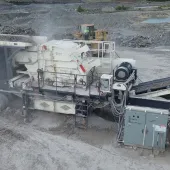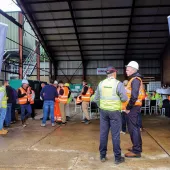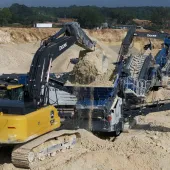McLanahan build their largest primary impactor

Hybrid New Holland-style machine weighs more than 90 tonnes and handles up to 3,500 tonnes/h
McLANAHAN have built and shipped the largest primary impact crusher they have ever manufactured – a New Holland-style impactor weighing more than 90 tonnes. The impactor, which has a 74in wide by 125in tall feed opening and can handle up to 3,500 tonnes/h of quarry shot rock, is capable of reducing feed lumps as large as 71in down to 6in with minimal fines generation.
McLanahan’s primary impact crushers are designed with several special features, including a high-inertia, solid-body rotor that uses less horsepower to process material, and a large expansion chamber to provide greater secondary breakage. Moreover, at 0.5hp per tonne, McLanahan’s New Holland-style impactor is said to use a fraction of the power that other impact crushers require to do the same job.
‘Between the angle of feed introduced into the rotor, the inertia of the rotor, and the expansion chamber, this allows for the performance that we get out of a New Holland-style machine that you don’t see in other types of impactors,’ said Mark Krause, managing director of McLanahan North America.
One advantage to this style of crusher is a reduction in the amount of fines produced. ‘Normally, the complaint people have about impactors is that they produce too many fines,’ continued Mr Krause. ‘This style of impactor is not going to produce that level of fines.’
Another feature of McLanahan’s New Holland-style primary impactor is a hydraulically retractable hood for unencumbered access to the interior. This is an advantage that McLanahan adapted from the Andreas-style impactor – another type of impact crusher that is shorter, wider, and requires more horsepower than a New Holland.
‘The original New Holland design did not have the hydraulic opening,’ Mr Krause explained. ‘It was designed so that people could crawl through side doors to get in and maintain it; they literally climbed inside the machine. By adding the hydraulics, it makes it a lot safer and a lot easier for people to get in and do the inspections and maintenance.’
As with any machine McLanahan design for a customer, the process begins with gathering as much information as possible about the application, including material type, feed gradation, maximum feed size, desired capacity, moisture content, required product size etc.
From there, McLanahan’s experienced engineering team uses the application data to design a machine that will be able to handle the feed material to meet product and capacity requirements at the lowest cost per tonne. Then they work closely with the production team during the manufacturing process.
Specifically, with a machine as large as this New Holland primary impactor, a great deal of planning is involved to ensure the process goes as smoothly as possible.
‘The biggest challenge with designing a machine of this size is bringing each piece together so they fit together as they should,’ explained engineering field service technician Blake Pinckney.
‘Before we finished with the design stage and moved into the drawing stage of this project, engineering sat down with manufacturing and went through each section of the machine to ensure the build moved smoothly through the shop.’
Once the impactor was assembled, all the moving parts, including the hydraulics and the rotor, were tested and inspected to ensure everything operated as designed. The machine was then disassembled and loaded on to trucks for shipping off to the customer.
‘We’re one of the few [manufacturers] who actually understand a New Holland design,’ said Mark Krause. ‘We can sit down and talk to somebody about their needs and deliver what they need.
‘Having an understanding of both Andreas and New Holland impactors and then being able to create a hybrid machine means we get to pick the best of both worlds. I don’t know anyone else in the world that does that these days.’









